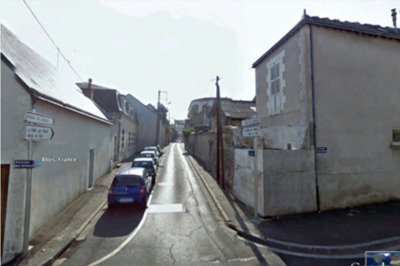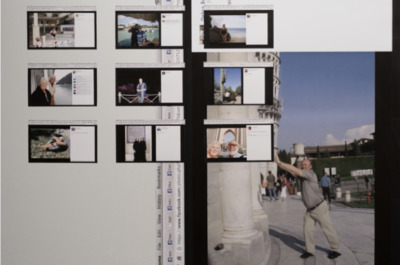Screen Capture in Digital Art and Literature: Interrogating Photographic, Interface, and Situatedness Effects

Christelle Proulx argues that screen captures in art and literature projects introduce three different effects on the representation of online world and its relation to offline world. The spatiotemporal specificities of the images produced are first considered through the photographic as a category of thought, then the importance of location is interrogated via the situated knowledges of Donna Haraway (1988) and concludes on the interface effects of this kind of imaging practice.
With a disarmingly simple gesture, a quick keyboard shortcut captures what appears on the screen, in part or in whole. Print screen: the practice is now a daily banality. It archives what scrolls on our screens and enable us to leave this momentary display of the present and its individual consultation. This way, we engage a wider reflection on the Web, its spatiotemporalities, its images and its modes of recordings. For this article, I would like to question the practice of screenshots as they are increasingly being used in digital art and literature. I will therefore analyze three different projects: After Faceb00k (2012-) (Image 1) and Laisse venir (2015) by Pierre Ménard and Anne Savelli. After Faceb00k archives photographs that are publicly shared on the platform by users since 2012 by bringing them together under different themes related to the place of their exhibitions. Similarly, the location is what drives Laisse venir, an electronic literature work that uses screenshots of Google Street View between Paris and Marseilles.

I argue that the spatial and temporal specificities of the representation of online world in screen captures introduce three different effects. The spatiotemporal cut in the online space is firstly highly related to the photographic, as a category of thought, although not as photography per se, as medium. The importance of location will then be interrogated as the situated effects, a “situatedness” in the online and offline world, in a manner similar to the situated knowledges of Donna Haraway. Hence the examination of the complex and dynamic relationship between digital objects and environments leads me to explore the various interface effects produced, as theorized by Alexander R. Galloway.
Milieu / Space
In order to make this statement, I start with After Faceb00k, a collective project of Montreal artists who have been collecting gems on the social network. The captures show the whole screen (Image 2); we can see the shared photograph in the middle, and the name of the individual who published the image, the metrics of appreciation, the comments, the URL of the page where the image was found, the name of the web browser, the different open tabs, the date and time of the capture or even the battery level of the artists’ laptops. While several other art projects reuse large number of images from Google, Instagram or Facebook by choosing to extract them completely from the platform, the practice of digital documentation that is put forward by projects like this allows the artists to capture the images in their environment : the screen, navigation tools, interfaces etc.

It seems obvious that the study of images must today be done jointly with that of its digital environment in order to observe their reciprocities, their dialogue, their tensions, the roles of one for the other. I defend the importance of the term milieu rather than environment in order to approach the screenshot. The first reason is its different meanings in French: milieu means a kind of environment but also the middle or the in-between. By examining its definitions in ecology or geography for example, the notion of milieu seems both more specific and multiple than those of environment and ecosystem, even if one does not exclude the other. In ecology, the milieu is “the part of the world with which a living organism is in contact“ (Saachi n.p.), which, in the Web, could represent the screen or better, the interface. By including the temporality of the continuous interaction among so many heterogeneous elements, the digital milieu captures the photographic object in its own natural environment, a center or a point of contact between the users and the Web.
Similarly, the electronic photo book by Ménard and Savelli emerge from an exploration of the digitalized streets traveled by the two authors between Paris and Marseilles, each employing a different trajectory to reach their destination. The written text works with the images in an especially rich dialogue between time, personal memories, individuals, past and present, and space, paths, places, both online and offline. The images extracted from Street View are partial captures, in contrast to After Faceb00k’s. There are fewer details referring to user interface, but the recognizable documentary aesthetics of Street view is unmistakable (Image 3) : a view from the streets, of course, but also its unnatural angles, scrambled faces and car plates, awkward visual stitching to create an illusion of continuity despite temporal discrepancies in between the snapshots.

Flux / Capture
As Matthew Allen explains in a short architectural exhibition catalog text entitled “The Screenshot Aesthetic“, the screenshots are images of representations: in After Faceb00k, they crystallize our way of seeing the world and his images through the social network. The invention of the “screen capture“ function goes hand in hand with the evolution of computer interactivity (Allen) and is used today to capture the constant motion of information scrolling in online space. The notion of flux is mainly used to address this continual movement of information. The flux in the strong sense of a flow, however, appears as an imaginary figure of what takes place behind the screens, in the manner of a film playing continuously, but our apprehension of the Web via an interface remains fragmented, cut by clicks , pages and windows, even if the pace is particularly fast. The screen is what allows the users to visualize and operate the interface, which decodes the continuous flow (Chatonsky 88). Flux is useful in order to address the incessant movements of information between devices: impossible to comprehend in their entirety. It is in these terms that Galloway addresses culture and the interface, to which I will return shortly, but I can already state that those effects are fundamental incompatibilities: it is the impossibility of reading the present as historical.
« Laisse venir » which means “let it come” in french is also very similar to this notion of flux. In a journey made on Street View, it is the places that are coming to us, by way of photographic records and an interactive platform. The text written by the two authors also revolves around the memories flowing from the images to the text and informing the online travel and the resulting digital photo book. The flux of the present time is even more palpable when one dwells on the stop that makes the screenshot. The captures stop the process so that it can be observed, partially, somewhat in synecdoque. Screenshots of Facebook and Street View remove the interactivity of the platform and fix the traces. The capture thus performs a freeze frame of what is “alive“, both fluctuating, localized and connected in the Web. These are photographic stabilizations that lie outside the real time of the flux to allow their observation outside of their original environment.
Screen captures’ photographic effect
The screen shot as used by After Faceb00k and Laisse Venir is a documentary practice that takes a sampling of what we are given to see daily and how it is shown. These documents thus prove to be an archive. The title After Faceb00k is evocative for this purpose: it suggests a work of conservation of a kind of online civilization doomed to disappear. It also refers to the appropriationist practice of Sherrie Levine as in After Walker Evans (1981), who similarly rephotographs a preexisting photo to make it her own. Moreover, I argue that the screenshot can be considered as a truly photographic act in that it fixes a piece of time and space (online and multiple) in one image. The capture signals an activity similar to hunting or kidnapping – taking the shot. To steal an image of the world, online or not, is something very photographic. After Faceb00k’s artists are actually hunting photos, employing various strategies and paths in search of hidden public areas where photogenic prey can potentially flourish; a photo safari in the jungle of facebookian banalities. These practices are not really photography per se, but certainly of the photographic order (even if the two are inextricably linked, one emanating from the other), as a category of thought, as Philippe Dubois explained in 1988 or Rosalind Krauss in 1990. The photographic grant us to think in terms of “referential registration“ or “effective pragmatic“ (Dubois 64). In other words: its documentary quality. Of course, no real action is transmitted and no duration is experienced since the screenshot fixes everything. This paradox is fundamental to the photographic perspective. Thierry DeDuve (115) explains well, in “Time Exposure and Snapshot: The Photograph as Paradox“, how the series of chronophotographs of Eadward Muybridge have only managed to demonstrate the gestures of a galloping horse without being able to show the movement in the long run. The action in real time (the flow?) does not let us observe the specific movements of a galloping horse, only the fixity and the series enable it.
Pierre Ménard, in Laisse _Venir also writes of his experience as a photographic one: “To write and photograph (without camera) in the same movement, the same dynamics. The same gesture?“ It is therefore a form of traveling in the images of others, of a traveling in the strata of time of various places. It certainly reminds us – or at least me – of the stereoscopic journeys and the famous armchair travelers who mass-consumed photographs at the end of the 19th century. Those intertwined cuts in time and space between production and reception resemble the illogical conjunction that Roland Barthes detailed about photography in “The Rhetoric of the Image” in 1964. Barthes writes that photography is both “immediate local and prior temporal“, in addition to being “an illogical conjunction between the here and the past“. In 1978, Thierry DeDuve proposed a complement to Barthes’ formula which also applies impeccably well to the screenshot by writing that it could also be something pertaining to the “now and there“ (DeDuve 1978: 117). “Screen photography” also means porosity because photography punctures a world into another. It is a specific moment in time and space represented in another.
Situated effects
The photographs taken from Facebook and Google Street View are therefore explicitly located in their milieu, a specific space and in a specific time also, that of the flux, via the screenshot. This spatiotemporal situatedness is crucial for the two projects and location seems to be one of the keys to understanding the current online and offline dynamics of representation. The second effect of the screen capture practice that I argue for is the situated effect. My perspective is largely inspired from Haraway’s feminist, embodied, localized, and processual perspective of knowledge production on the world of situated knowledges. The embodied vision of situated knowledge requires attention to the fact that we always see it from somewhere. Haraway writes “The only way to find a broader vision is to be somewhere in particular“.
The “After Faceb00k: Okanagan Valley“ exhibition (Image 4), held in Kelowna, British-Columbia in 2014, links this photographic investigation work to the urban development of the territory in which they exhibit. The artists looked at the phenomenon of gated communities, very present in the Okanagan Valley in British Colombia, Canada. These communities, many of which are adult-only, maintain socio-economic homogenization, behind physical boundaries that serve to contain standardized habitat (Aguiar, Tomic and Trumper). In their introductory text, the artists cite an article published in the Canadian Geographer that studies the marketing of the region as a place where it is good to retire, practice various hobbies, surrounded by similar people and mostly white.

The installation of screenshots printed on the walls of the gallery presents on one side a network of images of different communities and on the other a tighter assembly, where we find representative photographs of the population of closed communities. The artists isolated this photographic production in the exhibition in order to evoke the self-segregation of those who shared it. The artists are thus linking a specific part of the online universe and its dynamics of individualization of information, with a specific offline place, the gated community, also highly segregated. The project thus reiterates what has been called the filter bubbles (Pariser) or the information cocoons (Sunstein) of online information distribution and visibility. Haraway clearly claims the need for positioning in the production of knowledge and After Faceb00k in Kelowna brilliantly states the hybrid and mimetic nature of high proximity relationships in offline and online communities positions. The perceived freedom of privileged individuals and internet users often result in closed representations of the world, against exposure to alterity as a result of algorithmic or urbanistic developments.
This situated screen capture production is also highly incarnated in Laisse venir. The descriptions of places, environments, individuals and actions are explicitly stated from the situated viewpoint of the two authors. From the beginning of the journey, in Paris, Anne Savelli emphasizes the embodied aspect of the experience, even if it occurs online: “Wall / sky / parallax / what comes is the body / body of the observed world“. The world is actively observed as a body and from a body. Not only the vision in situated knowledges must be placed and “encarnated“, but mobile, able to move. This mobile location is especially apparent in the work of Ménard and Savelli, since the photographs produced by and for street view are made while and for moving. Trajectories of locations are literally what photographic documents produced by Google Street Views are for. Even though situated knowledges argue for the necessity of a partial instead of a global vision, the Street View tunnels of vision around the streets or the segregated informational environments in Facebook are not the kind of partial vision needed in the production of knowledge. These incomplete perspectives are coercive and dictated by the platforms, not the incarnated point of views we need. The relationship between the viewer and what is viewed and captured, which are photographs and interfaces, needs to be active.
Screen Captures’ interface effects
After the photographic and the situated, we can now consider the screen captures’ interface effect. Galloway states very clearly that: “Interfaces are not simply objects or boundary points. They are autonomous zones of activity. Interfaces are not things, but rather processes that effect a result of whatever kind” (i). The screenshot is therefore a trace of this process of passage, of what passes through the screen object and of this “autonomous activity area” that is the interface. Galloway’s interface “is the point of transition from one entity to another” (34). Thresholds in between entities are pictured by the screenshots of Facebook and Street View. They record not only the hybridity of online and offline worlds, but the various combinations of temporal and spatial points. What Galloway calls the “autonomous zone of interaction” produced by the interface is also consistent with the embodied and situated human sensorium in the situated knowledges.
A similar interface effect occurs in Laisse _Venir when the authors emphasize punctually in their texts the impression of being able to go where you want in Street View while noting the many points of inaccessibility: not being able to approach buildings or lanes at will, let alone to enter; nor being able to see a facade off to the side that has not been photographed. As noted earlier, the user interface is unable to situate the present as historic. As Galloway argues, “the truth of social life as a whole is increasingly incompatible with its own expression.” (i) But this incompatibility of the whole with its expression in Street View is an interface effect, a profound paradox of time and space.
The screenshot captures and records what appears on the screens: it gets a disconnected copy. Between the Web and its captures, avenues are created so as to observe a world and its traces outside of this world. Those constructed by After Faceb00k or Ménard and Savelli would not be considered as photography but as photographic in terms of a theoretical object that is a specific hybrid of time, space and visuality. This visuality is of foremost importance in the situatedness of these projects because what matters is the location, mobility and incarnation of the vision. After Faceb00k is anchored in specific places for a whole exhibition, while Laisse venir is made of two trajectories that are deployed over time. Then, as Galloway summarized brilliantly, “The interface effect is perched there, on the mediating thresholds of self and world.” (72). This active threshold standpoint is of uttermost importance when considering an image practice as the screenshot for its sociopolitical specificities, even outside of art and literature. These three effects offer some answers to much broader questions that need to be asked seriously. How we make the Web representable, how we capture it: this is the photographic effect. And then, how we look at it, how are we to analyze it ourselves, from our own viewpoint: a located, partial, mobile and situated effect. And lastly, how are we active in this relationship of image making in front of the screen. How are we negotiating this posture in between self and world, history and present, cultural production and sociohistorical situation? This is the spacetime threshold of the interface effect. An analysis of screen capture practices therefore leads us to question much more than contemporary imaging practices but the representability itself of spatiotemporal specificities in the relationships between online and offline world.
Cite this article
Proulx, Christelle. "Screen Capture in Digital Art and Literature: Interrogating Photographic, Interface, and Situatedness Effects" Electronic Book Review, 3 May 2020, https://doi.org/10.7273/jznf-6r32